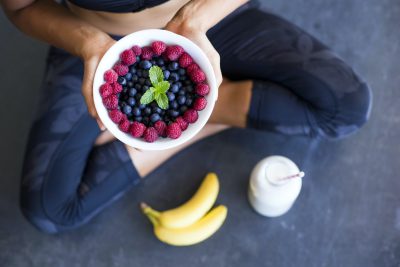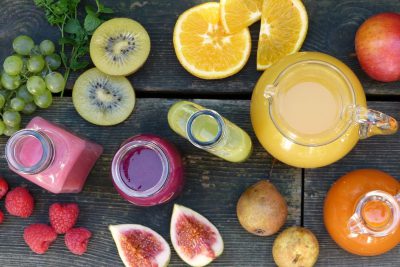The Standard American Diet versus WFPB
Research has found that nearly the entire U.S. population eats in a way that fails to provide them with the recommended daily intake of nutrients due to the lack of nutrient-dense plant foods such as fresh vegetables, fruits and wholegrains in their diets.
Unsurprisingly, studies show that people on a WFPB diet tend to consume more nutrients than those eating a Standard American Diet (SAD). Research also suggests that people who eat plant-based tend to have a lower rates of diabetes, and heart disease than those who eat meat.
Plant-based diets are also high in complex carbohydrates which, contrary to what some people might think, is not a bad thing at all. In fact, with a WFPB diet, you can consume as many bowls of rice, pasta, and potatoes as you like – provided the rice and pasta is wholegrain and the potatoes aren’t deep-fried!
Don’t Worry, Eat Happy!
Although eating a WFPB requires less nutritional diligence than eating a standard diet, you may still wonder if you’re getting enough of certain nutrients and, as a result, question what the best plant-based source of those particular nutrients might be.
To ease that worry, we’re going to cover off the big ones:
Getting your B12
A regular, reliable source of vitamin B12 is critical for all of us. Vegans are regularly advised to mind their levels of vitamin B12, but vegetarians and even meat eaters often come up short on this important nutrient too.
Vitamin B12 is made not by plants or animals, but by microorganisms (bacteria) that blanket the earth. In the past, vitamin B12 from bacteria was reliably present in plant foods but in today’s sanitized, modern world, and in addition to soil being exposed to more antibiotics and pesticides, most plant foods are no longer reliable sources of this bacterial product.
Animal foods, on the other hand, do tend to contain B12 because farmers often supplement animal feed with this vitamin. Farmed animals are also exposed to B12 through the manure in their living conditions, as well as through the manure they are sometimes fed (cows are often fed chickens’ poop). As a result, the FDA has reported that most meats are contaminated with fecal bacteria, in addition to containing B12.
If that grosses you out as much as it does us then fear not, because it’s possible to get sufficient amounts of B12 from B12-fortified foods or by taking a weekly supplement. For example: six teaspoons of B12-fortified nutritional yeast would (aside from making a delicious vegan-cheese sauce) provide us with our recommended daily intake (250 mcg) of this essential vitamin. Taking one 2,500 mcg supplement each week would also do the trick!
Protein
“Protein anxiety” is a condition commonly seen in people who have never had a protein deficiency, but worry constantly that they’re not getting enough! They load up on meat and eggs trying to avoid an imaginary lack of protein but, in doing so, increase their risk of developing a number of chronic diseases.
An average woman needs about 46 grams of protein per day; the average man about 56 grams, and a varied plant-based diet of whole grains, vegetables, and beans – while conversely lowering our risk of numerous chronic diseases – easily meets these needs.
Potent plant-based protein sources include broccoli, chickpeas, lentils, quinoa, nuts, chia seeds, seitan and tofu.
Iron & Vitamin C
It is often argued that plants have a lower bioavailability than the heme-iron in meat, and yet iron and vitamin deficiency in vegans is rare.
A 10-year study of 292,454 people indicated that heme-iron derived from meat increases the risk of heart disease by 57%. Conversely, non-heme iron derived from vegetables showed no relationship to risk or mortality from heart disease.
Excellent plant-based sources of iron include leafy greens, legumes (beans, lentils, and peas), tofu, quinoa, brown rice, tahini, pumpkin seeds, sunflower seeds, blackstrap molasses, dried fruit, oatmeal, cabbage, and tomato juice.
Consuming these foods alongside vitamin C-rich foods, such as papaya, pineapple, citrus, bell peppers, strawberries, Brussels sprouts and broccoli, will also help to improve iron absorption.
Omega 3
Omega 3 is a key feature of Blue Zone diets, famed for promoting increased longevity. There are actually three main forms of this essential fatty acid, all of which can be obtained from plants. They are:
- EPA (eicosapentaenoic acid)
- DHA (docosahexaenoic acid)
- ALA (alpha linolenic acid)
Seaweed and algae (also available in supplement form) can provide DHA and EPA fatty acids while the best plant sources of ALA include chia seeds, flaxseeds, hemp seeds, and walnuts.
Calcium
Calcium tends to be associated with dairy milk. Cows’ milk is the breast lactation of a pregnant or nursing cow, engineered by nature for growing her newborn calf. When we forcibly impregnate a cow and then take away her milk, we exploit the female reproductive system for a product that, much like a cat’s or dog’s milk, wasn’t meant for human consumption.
Contrary to marketing, cows’ milk doesn’t give us stronger bones. In fact, a large-scale Harvard study of individuals who drank very little milk versus individuals who drank a lot of milk found no relationship between calcium intake and fracture risk. Furthermore, a systematic review of the epidemiologic literature by the World Cancer Research Fund and American Institute for Cancer Research concluded there was a probable relationship between milk intake and increased risk of prostate cancer.
So, while calcium is an essential nutrient, plant-based calcium sources are definitely best. Leafy greens like kale, mustard and turnip greens, bok choy, broccoli, and spinach are particularly rich in calcium, but all whole plants actually have some level of calcium. You can also get calcium from fortified plant-based milks, such as cashew, almond, oat, and soy.
As mentioned earlier in this guide: if all of your calories are coming from whole plant foods, including plenty of fruits, greens, beans and other vegetables, then you don’t need to think twice about calcium requirements or do any milligram counting. You’ll be just fine.
Calories, Carbohydrates and Grains
While leafy vegetables are a key part of a WFPB diet, come packed with calcium and iron, and could literally be eaten by the bucket-load, they don’t actually contain enough calories to sustain us. Therefore, the center of your plate should tend to be starch-based foods that people around the world have thrived on for generations: foods like potatoes, sweet potatoes, corn, peas, quinoa, couscous, black beans, kidney beans, pinto beans, chickpeas, whole grain pasta and whole grain rice.
And on the subject of grains, oats and rolled oats are among the healthiest grains on earth. They’re a gluten-free whole grain and a great source of important vitamins, minerals, fiber and antioxidants. Studies show that oats and oatmeal have many health benefits, including lowering blood sugar levels, and reducing the risk of heart disease.
So what better way to start your day than with a warm bowl of oatmeal, or some delicious banana oatmeal pancakes?
Learn more about the many benefits of going vegan by signing up for our FREE Vegan challenges.



